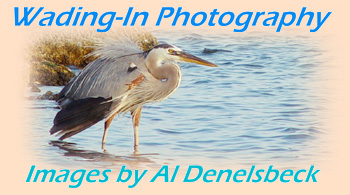Strange Encounters
First off, I'll warn you – the photos to go along with this story are weak, for several reasons. This is more of an anecdote with some mild assistance from illustrations, than it is a photo-essay.
Since I knew I was likely to be out wading in the water this day, I didn't bring along my primary camera kit, afraid of submerging it accidentally. Instead, I had an old Olympus OM77AF, which I believe is Olympus' first (of a very brief) foray into autofocus. This was manufactured back when autofocus was new, which meant it was balky, and manufacturer hadn't yet determined that the user would like the ability to override the camera sometimes.
Moreover, I was working on developing my black & white skills and had Ilford Delta 400 B&W print film loaded. In hindsight, this was an exceptionally poor choice. But anyway...
In April of 2003 I was busy exploring the area I live within. The nearby Indian River, which is actually an ocean inlet, is primarily bordered by privately-owned waterfront property, so access to it is extremely limited. However, I had discovered a spot on the utility company's right-of-way that would allow me access to the water, and used this from time to time. This particular day, as I was biking to this location, I passed a retirement community a hundred meters or so up the road, and noticed that many of the residents were out on the docks observing something downriver. I considered this a good sign – it probably meant that dolphins or manatees were present.
On reaching my spot, sure enough, I could see evidence of manatees roughly 130 meters offshore. At such a distance, there isn't much to see – generally, the slow appearance of a smooth humped back, or a snout that pops up for a few seconds as they gather their breath. West Indian manatees (Trichechus manatus) are air breathers that can stay under for several minutes at a time, and feed solely on water plants. They're painfully slow moving (which results in innumerable injuries from power boats), but often come into the shallows in their quest for both food and warmer water. For those who haven't seen one to scale, they are typically between two and three meters (6 to 9 feet) long, a meter (3 feet) or more thick, and average weight is between 185 and 370 kilograms (400 to 800 lbs). But they're harmless, gentle blobs for all that size.

The distance was too great for any decent look, though, and this wasn't good enough for me. So I started wading out into the water. At my chosen entry, the water stays shallow for a long distance out into the river, and I wasn't sure exactly how far. The manatees appeared to be in deeper water, but I needed to see how close I could get to them. I was in shorts and sandals, with the camera equipment in a belt pack. The bottom was smooth and very clear, but I was proceeding cautiously for a couple of reasons. First, that's just a habit of a nature photographer – don't spook anything, including the subjects you have not yet discovered. And second, I had recently spotted, at very close range, a few stingrays in these very waters. In fact, these sightings had prompted me to do a little more research on them, and I found that their sting, while quite painful, wasn't particularly dangerous to adults. So I wasn't taking a significant risk being in the water with them, but I was cautious all the same.
I was a perhaps a hundred meters off from shore, in water still only 75 cm deep (30 inches), when I noticed a pair of manatees break off and start to come closer. I stayed put, following them with the camera lens, but they eventually veered off and headed for deeper water. I slowly started further out again, but was reaching the limits of how deep I could get and keep the waist pack dry. The manatees, at least five of them, were surfacing a lot less frequently now and further away, so I figured I had spooked them.
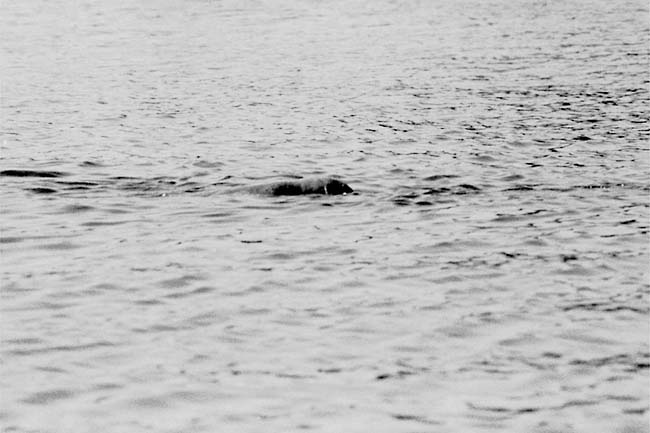
After about ten minutes, I wasn't seeing practically any sign of them anymore and decided the opportunities were past, so I turned back towards shore. This demonstrated that I had been lax in my normal nature photography habits of watching my entire surroundings – while I was staring out at the last area that I'd seen them, they had been circling around. The manatees were now even with me in relation to the shore, and getting closer to the bank all the time. I was quite surprised that they seemed perfectly comfortable in water so shallow that they were barely submerged. I also had to back off from my maximum focal length of 210mm, because they were now too close and were overfilling the frame.
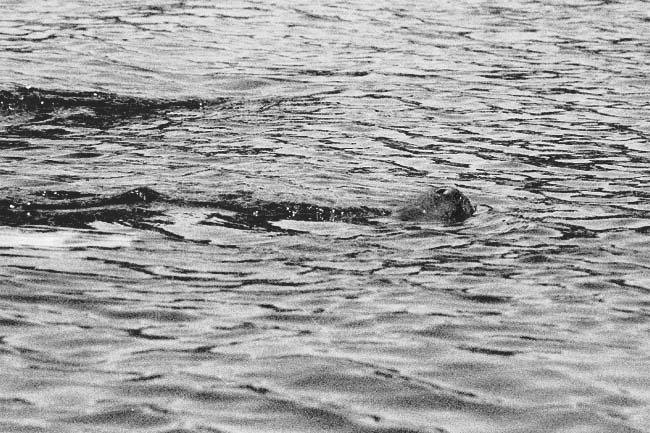
The whole group, seven now by my reckoning, had circled completely behind me and were between me and the shore, at an average distance of seven meters (twenty-two feet). The closest ones could be seen clearly through the surface, including the propeller scars that nearly every adult manatee bears, and distinctly enough that I could identify them again from these markings. However, with B&W film and the rippling surface reflecting the sunlight, these pics yielded no detail to differentiate the manatees from the surface.
Abruptly, I realized one had broken from the pack and was drifting directly towards me at about half of a walking pace. I was standing perfectly still and trying desperately to get the autofocus of the camera to lock onto the head of the manatee below the surface of the water, and not the surface itself. While the camera threw things into and out of focus, my other eye watched the giant approach ever so causally.
At a distance between 1.5 and 2 meters (four to six feet), the autofocus finally locked onto the head, which was huge under the surface. At this exact instant, the manatee apparently realized I was practically within touching distance and those were not pilings dead ahead, but legs. It flinched sideways sharply, and a round tail the size of a washtub curled out of the water and slammed down with a resounding crack.
I was made aware that this is apparently as much a danger signal to manatees as it is to beavers, because all hell broke loose. With many times more energy and speed that I have ever seen demonstrated before or since, the entire group thrashed madly for deeper water, thankfully detouring around me. The surface was whipped into a froth and the turbulence must have been audible halfway across the river. I was frozen in place, whipped by spray and horrified by what I had unwittingly caused, but I recovered presence of mind enough to snap a frame as they passed.
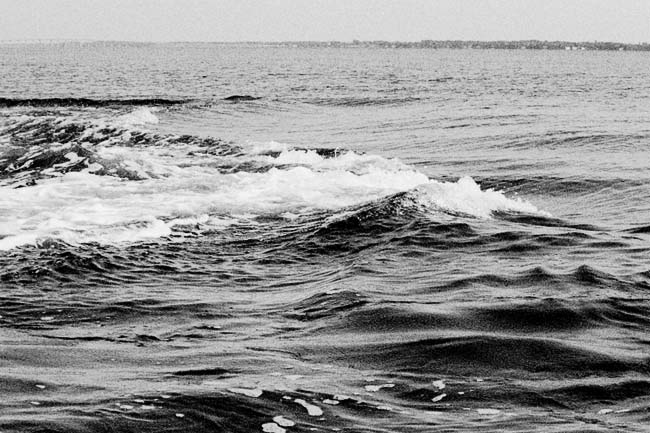
And silence. The ripples died down, and I stood there in embarrassment even though I had really done nothing at all. Harassing manatees is against the law, and I wasn't sure if I had been observed or not, and if so, what anyone might think. But I stayed put. Nature photography has taught me to assess a situation before abandoning it, and I wanted one last look around at the area before I headed in. I was also frustrated over missing the closeup of a manatee practically at my feet in shallow water. And as I watched, I realized the entire group had halted about twelve meters (forty feet) away and were milling about. They were surfacing much more frequently than normal, but whether this was from their recent exertion, or to keep an eye on me, I can only speculate.
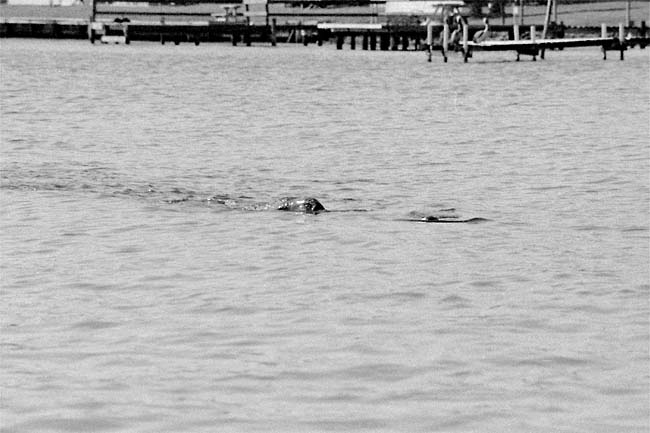
The next part was startling, and a bit gratifying. The entire group, at a faster pace than their normal meandering in search of food, curved back around and approached me in a broad circle. Without pause, they all passed within three meters (ten feet) of me, no panic, no threat, and seeming to be perfectly aware of my presence. This was not five minutes from their mad dash to safety. Then, having paraded past, they headed for deeper water and downriver. In the photo below, you're seeing the closeup of a nose.
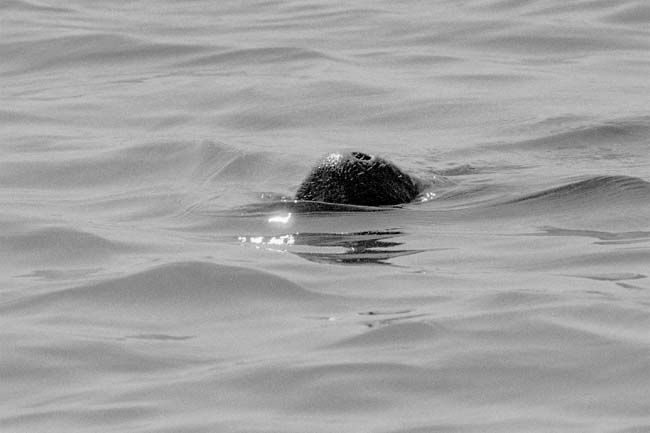
The last part I have no good explanation for, knowing too little about manatee habits. It made no sense from the standpoint of any threatened animal, because I had not changed position since the panic and it seemed abundantly clear they knew exactly where I was. While I would certainly like to take it to be a 'no hard feelings' pass, I can't honestly ascribe such emotions to any animal (or even many humans). The best guess I have is that the one that approached the closest, and started the dash for safety, had startled itself seeing me looming over the surface, triggering the others blindly. And once they had assessed the situation, they assured themselves as a group that I was only a wader. Manatees are protected in the States, and not only cannot be hunted, they are often fed by people, even though this is actively discouraged because it is believed to foster unnatural feeding patterns. But the pattern is of mankind not posing any direct threat to the species, so it is possible they consider people in a neutral or mildly favorable light.
I left, elated at the close contact, and after their return pass, no longer embarrassed by their panic. Since that time, I've had several opportunities for close shots from shore, but never as close as the opportunity I blew on this day. Even snorkeling with a disposable underwater camera, manatees haven't let me get near enough yet for a clear photo. I'm still holding out hope, though.
